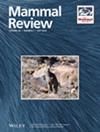通过化石记录研究欧洲西南部白齿鼩(Crocidura iculisma,Eulipotyphla)全新世的生物地理特征
IF 4.4
2区 生物学
Q1 ECOLOGY
引用次数: 0
摘要
Crocidura iculisma(=C. suaveolens)是一种鼩鼱科(Soricidae,Eulipotyphla)动物,分布于伊比利亚半岛、法国南部和西部以及意大利西北部。虽然自中更新世以来它就一直在伊比利亚半岛活动,但其生物地理历史仍然鲜为人知。在这里,我们提供了来自 Castillejo del Bonete 遗址(西班牙南部)的 Crocidura iculisma 的新数据,其年代为公元前 3.8-3.6 千年。同时,我们还根据其古生物学记录分析了其地理分布的变化。我们全面审查了欧洲西南部全新世的 Crocidura iculisma 记录,并根据该地质年代系列所定义的阶段(格林兰期、北格里皮期和梅加拉亚期)独立考虑了三个时间段。只要在化石遗址中发现两种同域鼩鼱(Crocidura russula 和 Crocidura iculisma),就会对其相对丰度进行分析。所获得的有关过去分布范围和相对丰度的数据与伊比利亚的物种现状进行了比较,以解释不同时期的变化。随着时间的推移,西南欧白齿鼩在伊比利亚半岛的分布范围明显缩小,直至今日。卡斯蒂列霍-德尔-博内特(Castillejo del Bonete)的发现以及位于其目前分布范围之外的其他古生物记录表明,至少在梅加拉亚后半期之前,白齿鼩还分布在伊比利亚东部和南部内陆的一些地区。在化石群中观察到的相对丰度模式表明,Crocidura russula 的竞争性排斥和气候变化在促使 Crocidura iculisma 从伊比利亚半岛的大部分地区灭绝方面发挥了至关重要的作用。本文章由计算机程序翻译,如有差异,请以英文原文为准。

Holocene biogeography of the southwestern European white-toothed shrew (Crocidura iculisma, Eulipotyphla) through its fossil record
求助全文
通过发布文献求助,成功后即可免费获取论文全文。
去求助
来源期刊

Mammal Review
生物-动物学
CiteScore
12.20
自引率
4.10%
发文量
29
审稿时长
>12 weeks
期刊介绍:
Mammal Review is the official scientific periodical of the Mammal Society, and covers all aspects of mammalian biology and ecology, including behavioural ecology, biogeography, conservation, ecology, ethology, evolution, genetics, human ecology, management, morphology, and taxonomy. We publish Reviews drawing together information from various sources in the public domain for a new synthesis or analysis of mammalian biology; Predictive Reviews using quantitative models to provide insights into mammalian biology; Perspectives presenting original views on any aspect of mammalian biology; Comments in response to papers published in Mammal Review; and Short Communications describing new findings or methods in mammalian biology.
 求助内容:
求助内容: 应助结果提醒方式:
应助结果提醒方式:


